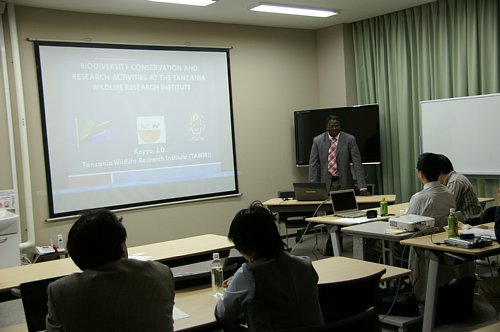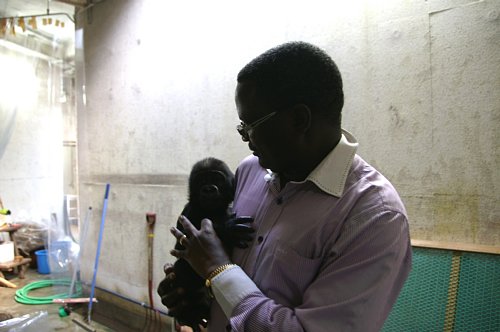|
<NEWS>
Dr. Julius Keyyu Visits WRC
Gen’ichi Idani
Kyoto University, Japan Dr. Julius Keyyu, Director of Research at the Tanzania Wildlife Research Institute (TAWIRI), visited Japan in May 2012. He was invited by the Wildlife Research Center (WRC), Kyoto University to attend an international symposium “Wildlife Studies in Tanzania” and a workshop “Prospect and Cooperation for Wildlife Research in Tanzania”. The study of great apes by Japanese researchers in Tanzania was pioneered by the late Dr. Kinji Imanishi and the late Dr. Junichiro Itani in 1961. In 1965, the late Dr. Toshisada Nishida was successful in provisioning wild chimpanzees in the Mahale area, and Mahale Mountains National Park was established in 1985 as the 11th National Park in Tanzania. Research in Mahale Mountains N. P. under the leadership of Dr. Nishida produced a lot of important results. Key findings included the existence of the unit group (community), exchange of females among unit groups and the patrilineal structure of chimpanzee society, fission and fusion of individuals within a unit group, male alliances and dominant-subordinate relations, conflict between unit groups, various sexual behaviors, infanticide and cannibalism, sharing behavior, cultural behaviors, including tool-using behaviors. It can safely be said that these findings played an important role in developing our scientific understanding of a few differences between chimpanzees and human beings. At the same time as work was beginning at Mahale, field research of wild chimpanzees was also carried out in the Ugalla area, which is located 100 km north-east of Mahale. Dr. Takayoshi Kano (now an honorary professor of Kyoto University) stayed alone in Ugalla during 1965-1967 and conducted a distribution survey of chimpanzees in Western Tanzania. In this survey, he established that the eastern limit for the distribution of chimpanzees in Tanzania was at long. 31°1′ E on the left bank of the Ugalla River, and the southern limit was at lat. 6°38′ S of the Wansisi Hill. The left bank of the Ugalla River is also the eastern limit of the distribution of the chimpanzee in Africa. Unfortunately, research in Ugalla was not continued after that because efforts were concentrated on work at Mahale. In 1994, however, Dr. Hideshi Ogawa (Chukyo University) and I resumed the survey in Ugalla and studies there continue to the present day. Dr. Ogawa revised the southern limit of the distribution of chimpanzees in Tanzania to lat. 8°12′ S. We have also revealed unique ecological characteristics of the miombo arid woodland of Ugalla, and interesting studies of various mammals and raptors have been initiated there. The program of the symposium held on 16th May, 2012 is shown below. It began with a keynote presentation by Dr. Keyyu, who introduced activities and research in TAWIRI, and then the latest studies were described in three presentations for each of Mahale and Ugalla. These presentations dealt not only with chimpanzees, but also referred to various other fauna, including raptors, and to the vegetation and climate. The symposium stimulated active discussion among many researchers and students. We would like to express our sincere thanks to all of the participants in this symposium. 
On the following day (the 17th May), a closed workshop was held among Dr. Keyyu and researchers of Mahale and Ugalla. We discussed future collaboration between TAWIRI and WRC in scientific research, conservation and education. Studies in most of the 16 national parks and 10 reserves for wild animals in Tanzania have been carried out by European and American researchers. Japanese researchers have mainly promoted studies in Mahale and Ugalla in western Tanzania. Although there is the Katavi National Park in the south of Mahale, foreign researchers seldom work there. So we also discussed a plan for Japanese researchers to develop studies in the whole of western Tanzania, from Katavi N.P. to Mahale and Ugalla. This workshop was a valuable event. One excellent outcome was an agreement to form a MOU between TAWIRI and WRC in the near future. 
Dr. Keyyu had friendly discussions with researchers and students at WRC, and he also visited Kyoto City Zoo and Kyoto Aquarium. He was deeply touched to see a newborn gorilla in the zoo and wondered at the exhibits of great salamanders and dolphins in the aquarium. Though his stay in Kyoto was only 4 days, it was a fruitful time, and he left for home on 19th May. We hope that TAWIRI and WRC will develop more on each research and activity in Tanzania.
<Symposium For Wildlife Studies In Tanzania>
<Workshop for Prospect and Cooperation for Wildlife Research in Tanzania (Closed)> Back to Contents |